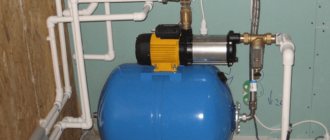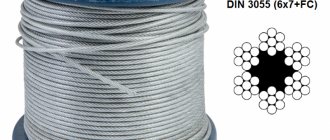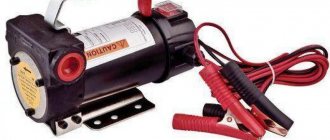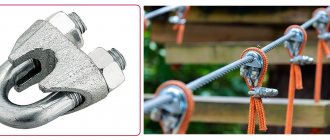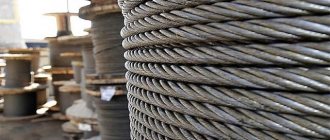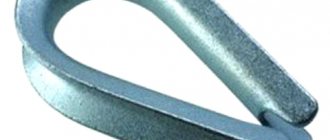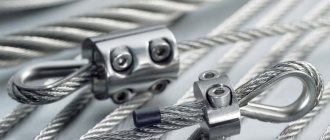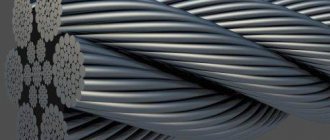HOW WORKING STRENGTH INDICATORS ARE CALCULATED
The strength of cables and ropes for production purposes is regulated by the relevant GOSTs:
- GOST 2688-80 – steel ropes, cables, slings for cranes (construction, metallurgical), installations in mines;
- GOST 3068-88 – ropes and cables for road, construction equipment, lifting and transport mechanisms, earth-moving equipment;
- GOST 7668-80 – universal steel cables for metallurgical, industrial lifting works, construction;
- GOST 7669-80 – cables and ropes for winches, excavator buckets, mine hoists;
The strength of a steel cable is determined by two criteria:
- tensile strength of cables is a calculated value that determines at what minimum loads the steel cable begins to fail;
- working strength or permissible force is an indicator of operational capabilities, optimal loads on the cable under which it can be operated for a certain period without breaks or destruction. This indicator determines what working loads are permissible for a steel rope.
Tensile and working strength depends on production technology, design, and degree of rigidity. The higher the rigidity of the cable, the higher the tensile strength.
Length and load?
There is no need to bother with the length of the tow rope: its value is indicated in the traffic regulations. It should be from 4 to 6 meters. Another thing is worse: the cable must be marked with flags or shields of the established type, which cable manufacturers for some reason forget about... It may very well be that such flags-shields will have to be purchased separately: otherwise you have the right to be punished. As for the force indicated on the cable packaging, in practice the most common are 5-ton cables, which are suitable for towing almost any passenger car.
Pay special attention to the length. If the cable is too short, then at the first sharp braking the towing vehicle will regret its kindness: the towed person will drive into the rear part of the body. But a cable that is too long is not a gift: think about how you will turn into an alley or, even worse, into a gateway? The tugboat will calmly go around the corner, but the long cable will drag you to the side, aggravating the troubles.
An example of a tow belt with a working load of 4 tons and a minimum breaking load of 6 tons. Ideal for vehicles with a curb weight of up to 2 tons. Tape material - polyester, design: "hook/hook".
An example of a tow belt with a working load of 4 tons and a minimum breaking load of 6 tons. Ideal for vehicles with a curb weight of up to 2 tons. Tape material - polyester, design: "hook/hook".
Dynamic cable "DorNabor" (12 tons, 9 meters) is intended for vehicles weighing from 2000 to 3500 kg. This should cope with almost any SUV stuck in the mud. By the way, the sling was made in Russia.
Dynamic cable "DorNabor" (12 tons, 9 meters) is intended for vehicles weighing from 2000 to 3500 kg. This should cope with almost any SUV stuck in the mud. By the way, the sling was made in Russia.
Towing belt with a working load of 4 t
Dynamic sling (12 tons, 9 meters), DorNabor
A snatch cable requires a slightly different approach. Products with a specified load of 4.5-4.6 tons can be used to pull out stuck snowmobiles, ATVs and cars. For vehicles weighing no more than two tons (which is almost all passenger cars), cables with a load of 8–9 tons are suitable. And if we are talking about such “rogues” as Land Rover Defender 110, Land Cruiser 100/110, etc., then cables with a load of 11–14 tons will be required. As for the product with a stated load of 15–18 tons, they are suitable for Hummers and their brothers.
The length of snatch cables is usually from 5 to 12 meters. On average, it is better to focus on a length of 9 meters. As for the price, cheaper products are suitable, in general, for anyone who is not going to specifically climb into some kind of jungle. But expensive ones are needed precisely by those who are going somewhere special.
APPLICATION AREA
The use of steel rope can be found in various fields. This can be as a cable for mounting a tent and cable-stayed roof structures to suspension bridges and television and radio towers.
Different applications for wire ropes place different demands on strength, abrasion and corrosion resistance. To meet these requirements, the cable is made of materials such as:
- Stainless steel. Used where corrosion is a major factor.
- Galvanized carbon steel. It is used where strength comes first and corrosion resistance is less important.
The wire (one element) can have a cross-section of up to 3 mm. This is enough to withstand loads of up to 200 kgf/mm2. Steel cables and ropes differ in terms of lay, which can be single, double or triple. The arrangement of the wire in different layers has one of the following tangents:
- point (usually used for minor intermittent loads);
- linear (used in many areas);
- point-linear (used for additional strength).
How to go?
It’s harder for the towed person to drive. In the film “Morning Detour,” the hero of Andrei Myagkov, whose Moskvich took some kind of truck in tow, tries in vain to stop him, because he simply... forgot about him! Therefore, the tug driver needs to look in the mirror more often: has he lost the poor guy somewhere along the way...
The vehicle being towed must have functioning steering and brakes. Before driving, be sure to unlock the steering wheel.
- If you have any questions about the selection and proper operation of cables, as well as the necessary accessories for them, please contact the Za Rulem online store! According to good tradition, prices for the entire range have been reduced for the period of publication of the article.
5 principles of towing: choosing the right cable
Tags
cargo ropes GOST rope Double steel rope GOST Rope GOST roads. Galvanized ropes Rope steel steel rope GOST Rope GOST that rope not all wires steel all wires in all wires touching wires touching wires including wires in thick wires gives touching wires in all wires touching wires in LC from LC where LC nowhere LC not GOSTs to GOSTs to GOST 3241 GOST 25835 GOST 33166.1 GOST 33709.1 GOST 3241 steel GOST 2688 necessary GOST or GOST ropes
calculated sling of cranes din mass of smeared layer weight of blocks of each machine standard length of equipment to use technical mechanism maximum lifting large identical availability
Steel cable - product types and markings
Each type of steel cable design has its own specific features that must be taken into account when choosing a product for a particular purpose. Don’t forget about the general parameters that you should know when going to the supplier - length, diameter, maximum load that the product will have to withstand. Now a few words about the design features. There are single lay cables, where a round wire is wound in a spiral around the core. As a rule, this is a strand for making more complex structures - ropes. Double lay cable is no longer produced from individual wires, but from the strands mentioned above, which are applied to the core according to certain rules. Here you can make single-layer and multi-layer cables. They are able to withstand considerable weight and, with a certain method of wrapping, cannot twist during operation; this property sometimes greatly simplifies operation. There is also a triple lay, such a cable is twisted from strands, this is the name of double lay products, specially designed for subsequent use in the manufacture of more complex and stronger cables.
Rope markings
All of the above properties of the rope are reflected in its markings. Examples:
- Rope 10.5-GL-VK-OZh-MK-L-N-R-T-1770 GOST 3077-80 - rope with a diameter of 10.5 mm, heavy-duty, grade VK, galvanized according to the "OZh" group, low-twisting, left cross lays, non-unwinding, increased manufacturing precision, marking group 1770 according to GOST 3077-80
- Rope 17-G-V-S-L-O-N-T-1470 GOST 3079-80 - rope with a diameter of 17.0 mm, cargo purpose, grade B, galvanized according to group C, left one-sided lay, non-unwinding, increased accuracy, marking group 1470 N/mm 2
For more detailed advice, please contact our managers.
For the production of steel cables, the requirements for which are specified by GOST 2688-80, a special wire is used, which is preliminarily subjected to heat treatment, which gives it high strength. Steel cable is actively used in various industries: oil refining, coal mining, construction, in the operation of sea and river transport, etc.
Areas of use of steel cable
Currently, towing steel cable is most often in demand in lifting and traction mechanisms (overhead cranes, excavators, drilling rigs). It can also be used in elevator shafts as a lifting mechanism. It is widely used in reinforcing reinforced concrete structures. Due to its high reliability, the rope can withstand enormous loads and is freely used in the process of heavy construction manipulations, for example, for lifting concrete slabs to the height of a nine-story building. Rope slings are made from steel cables - load-handling, strong, flexible devices that are used when loading any large objects.
It is worth noting that when choosing a steel cable for a winch or other mechanisms, you should turn to the opinion of professionals, since among the current variety, a beginner will not be able to choose the right product for himself. Additional elements supplied with cables undergo special tests and must comply with the necessary regulations and certificates. The main working qualities for a rope are flexibility, maximum tension values, strength and load-carrying capacity. Don’t forget about the processing nuances that allow you to extend the life of the cable in an aggressive environment. For some applications, the weight of the steel cable is important, and sometimes this can even become a reason to abandon this device.
Characteristics displayed in the labeling
All main parameters of load-bearing elements are indicated in their markings with the appropriate symbols.
Ropes can have an organic (OS) or metal (MS) core, right or left (L) laying direction of the strands, one-sided (O) or double-sided weaving, be unwinding and non-unwinding (H), straightened (R) or not straightened, with zinc coating for particularly harsh (OZH), severe (G) or moderately aggressive (C) operating conditions or without coating, manufactured with normal or high (T) precision.
According to mechanical characteristics, equipment is divided into brands:
- high quality (VK),
- ordinary quality (B).
And according to their purpose, products are divided into:
- cargo-human (GL), used for transporting people and cargo;
- cargo (G), created only for the transfer of goods.
In addition to the above parameters, the marking indicates the diameter of the device, the temporary resistance of the wires (N/mm2), GOST (TU) according to which it is manufactured.
To describe a cargo rope made in accordance with GOST 2688-80, having a diameter of 18 mm, right-hand cross lay, increased manufacturing accuracy, high quality grade and tensile strength of 1570 N/mm2, galvanized for work in conditions of medium hardness, the following marking will be used:
Rope 18 G-VK-S-T-1570 GOST 2688-8
The cable should be selected, paying special attention to strength, so that the product performs its functions in transporting goods for a long time and reliably.
How long does a 12mm cable last?
Characteristics of steel cables
| Cable diameter , mm | Estimated weight of 100 linear meters of cable , kg | Estimated tensile strength of cable , kg/ mm 2 |
| 12.0 | 59,27 | 9090 |
| 13,5 | 74,95 | 11450 |
| 15,0 | 92.50 | 14150 |
| 16,5 | 111.9 | 17 150 |
Design difference
Technical conditions imply various equipment in the manufacture of cables, but there are basic rules that all manufacturers adhere to. The structure of the cable is not one continuous thread. To assemble it, a certain number of steel wires are used, which are intertwined with each other. The design contains a core around which winding is carried out. The core may not necessarily be metal. In some solutions it does not bear the main load, but provides the shape of the final product. In addition, its function is to maintain roundness under mechanical stress. The core, like other elements, is coated with an anti-corrosion compound based on zinc or aluminum.
In addition to metal cores, cotton cable, film, manila or sisal can be used for cables. Organic materials tend to degrade under the influence of bacteria and putrefactive processes. That is why, for strength, they require treatment with special compounds. They are various lubricants, which also reduce friction of components, which reduces internal stress. It would be wrong not to mention the possibility of using various synthetic threads as a core. Most often they are made of polyamide, which has excellent strength characteristics. A portion of polyamide threads is placed as a separator between the metal components of the cable, which eliminates friction and extends service life. The advantage of such solutions is the reduction in weight of the structure.
Note! The metal cores can be plates or wires, which are also insulated from the other components.
All steel ropes are classified according to their level of flexibility:
- hard;
- medium flexibility;
- increased flexibility.
The main criterion by which such a distinction is made is the quantity and material of the core. In the first version, the core is 42 wires and additional organic components. For medium flexibility, the number of wires in the core is increased to 72, and in flexible ones it reaches 144 pieces, which are divided into 6 separate strands.
Transportation and storage
5.1. Ropes are transported by all types of transport in covered and open vehicles in accordance with the rules for the transportation of goods in force for this type of transport. The placement and securing of cargo during rail transportation is carried out in accordance with the Rules for Loading and Securing Cargo, which are in force in accordance with the established procedure. Transportation of ropes by rail is carried out by carload, low-tonnage or small shipments. 5.2. Storage of ropes - according to the conditions of 5 GOST 15150. When storing the user of a rope wound on a drum, the axis of the drum must be parallel to the floor on which the drum is installed. Ropes received for storage are subject to immediate inspection and lubrication of rope sections exposed during transportation and loading and unloading operations with rope lubricant. During long-term storage, ropes must be periodically inspected at least every 6 months on the outer layer and lubricated with rope lubricant.
Delivery within the Russian Federation:
Moscow, St. Petersburg, Arkhangelsk, Astrakhan, Barnaul, Belgorod, Bryansk, Vladimir, Volgograd, Vologda, Voronezh, Ekaterinburg, Ivanovo, Izhevsk, Yoshkar-Ola, Kazan, Kaluga, Kirov, Kostroma, Krasnodar, Kurgan, Kursk, Lipetsk, Omsk, Orel, Orenburg, Penza, Perv, Pskov, Rostov-on-Don, Ryazan, Samara, Saransk, Saratov, Sevastopol, Simferopol, Smolensk, Stavropol, Tambov, Tver, Tomsk, Tula, Tyumen, Ulyanovsk, Ufa, Chelyabinsk, Yaroslavl and others.
